

7 Tenets of Creative Thinking. In school, we learn about geniuses and their ideas, but how did they get those ideas?
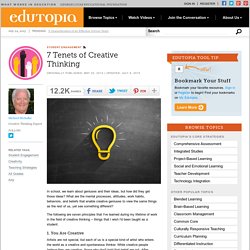
What are the mental processes, attitudes, work habits, behaviors, and beliefs that enable creative geniuses to view the same things as the rest of us, yet see something different? The following are seven principles that I've learned during my lifetime of work in the field of creative thinking -- things that I wish I'd been taught as a student. 1. You Are Creative Artists are not special, but each of us is a special kind of artist who enters the world as a creative and spontaneous thinker. 2. You must show passion and the determination to immerse yourself in the process of developing new and different ideas. 3. When producing ideas, you replenish neurotransmitters linked to genes that are being turned on and off in response to challenges. 4. Your brain is a dynamic system that evolves patterns of activity, rather than simply processing them like a computer. 5. 6. 7. Yes, You Can Teach and Assess Creativity!
A recent blog by Grant Wiggins affirmed what I have long believed about creativity: it is a 21st-century skill we can teach and assess.

Creativity fosters deeper learning, builds confidence and creates a student ready for college and career. However, many teachers don't know how to implement the teaching and assessment of creativity in their classrooms. While we may have the tools to teach and assess content, creativity is another matter, especially if we want to be intentional about teaching it as a 21st-century skill. In a PBL project, some teachers focus on just one skill, while others focus on many. Here are some strategies educators can use tomorrow to get started teaching and assessing creativity -- just one more highly necessary skill in that 21st-century toolkit. Quality Indicators If you and your students don't unpack and understand what creativity looks like, then teaching and assessing it will be very difficult.
Activities Targeted to Quality Indicators Model Thinking Skills. The Science (and Practice) of Creativity. "Creativity isn't about music and art; it is an attitude to life, one that everybody needs," wrote the University of Winchester's Professor Guy Claxton in the lead-up to the 2014 World Innovation Summit for Education (WISE) dedicated to creativity and education.
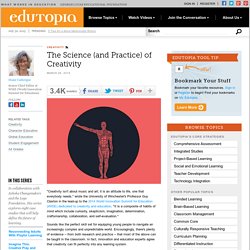
"It is a composite of habits of mind which include curiosity, skepticism, imagination, determination, craftsmanship, collaboration, and self-evaluation. " Sounds like the perfect skill set for equipping young people to navigate an increasingly complex and unpredictable world. Encouragingly, there's plenty of evidence -- from both research and practice -- that most of the above can be taught in the classroom.
Legendary Designer Charles Eames on Creativity, the Value of the Arts in Education, and His Advice to Students. By Maria Popova “There is always a need for anyone that can do a simple job thoroughly.”
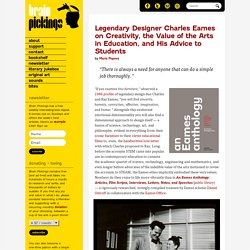
“If you examine this furniture,” observed a 1946 profile of legendary design duo Charles and Ray Eames, “you will find sincerity, honesty, conviction, affection, imagination, and humor.” Alongside this exuberant emotional dimensionality you will also find a dimensional approach to design itself — a fusion of science, technology, art, and philosophy, evident in everything from their iconic furniture to their clever educational films to, even, the handwritten love letter with which Charles proposed to Ray. Long before the acronym STEM came into popular use in contemporary education to connote the academic quartet of science, technology, engineering and mathematics, and even longer before advocates of the indelible value of the arts motioned to revise the acronym to STEAM, the Eames ethos implicitly embodied these very values.
Beautiful Oops. Art Lab for Kids. Steal Like an Artist (Age 16+) The Artists Way (Age 16+) One Day on Earth. The Big Picture. DRS.
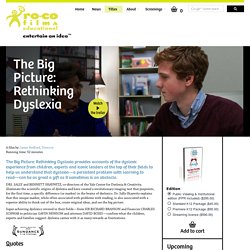
SALLY and BENNETT SHAYWITZ, co-directors of the Yale Center for Dyslexia & Creativity, illuminate the scientific origins of dyslexia and have created a revolutionary imaging test that pinpoints, for the first time, a specific difference (or marker) in the brains of dyslexics. Dr. Sally Shaywitz explains that this unique marker, while often associated with problems with reading, is also associated with a superior ability to think out of the box, create original ideas, and see the big picture. Super-achieving dyslexics revered in their fields—from SIR RICHARD BRANSON and financier CHARLES SCHWAB to politician GAVIN NEWSOM and attorney DAVID BOIES—confirm what the children, experts and families suggest: dyslexia carries with it as many rewards as frustrations.
Quotes "An exemplary example of educational documentary filmmaking. " "We screened The Big Picture here at Campbell Hall with our entire faculty and staff at opening faculty meetings. Most Valuable Players. Across the USA, high school sports are regularly lavished with funding, publicity and scholarships, while theater departments struggle to put on the school musical hoping for some recognition of their own.

Helping to settle the score are the "Freddy Awards," a live television event that celebrates excellence in high school musical theater. Illustrating that arts education encourages the same teamwork, camaraderie and confidence as sports, Most Valuable Players follows three theater troupes on their creative journeys to the elaborate award ceremony — the "Super Bowl" of high school musical theater. Official Selection, Oprah Winfrey Network Documentary Film Club "The feel good documentary of the year"—IDA "FUNNY...COMPELLING"—USA Today "A THRILLING DOCUMENTARY"—The Huffington Post "A really entertaining documentary"—Variety. A Child's Garden of Poetry (Age 4+) Singin' in the Rain (Age 6+) Wallace & Gromit in Three Amazing Adventures (Age 7+) Being Elmo (Age 8+) The LEGO Movie (Age 8+) Mad Hot Ballroom (Age 8+)
At first, it might seem strange to see such young people working so seriously on ballroom dancing.

But within minutes, Marilyn Agrelo's documentary convinces viewers that this is exactly the right activity for these dedicated, enchanting fifth-graders. As they work with their teachers and each other to learn the difficult steps and postures for the rumba, tango, swing, merengue, and fox-trot, they also reveal much about themselves as thoughtful, dynamic young people.
As they dance, they are exposed to various cultural traditions and begin to learn traditional gender roles (the boys are instructed, "Take care of your partner"). More than anything else, the movie impresses by the respect it affords its subjects. Whether the dancers perform for the camera (which some of them certainly do), explain their interest (Michael Vaccaro says, "It's like a sport that hasn't been invented yet! ") The Artist (Age 13+) Pan's Labyrinth (Age 15+) Pollock (Age 16+) Frida (Age 16+) Mozilla Thimble (Age 12+) Google Art Project (Age 12+) NaNoWriMo Young Writers Program (Age 13+) Built by Kids (Age 13+) 99U (Age 15+) Juxtapoz (Age 18+) It's Nice That (Age 18+) Global Scribes. Create Online: Sites to Spark Kids' Creativity. Get our best picks for movies, apps, TV shows, books, and more, customized for your kids.
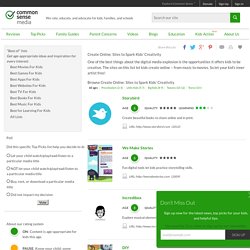
Get the App Get the App No thanks close(x) Don’t Miss Out You’re all set! Look out for our weekly updates soon. Connect with us Jump to navigation "Best of" Lists "Best of" lists Get age-appropriate ideas and inspiration for every interest: Poll Did this specific Top Picks list help you decide to do any of the following? Let your child watch/play/read/listen to a particular media title 41% (739 votes) NOT let your child watch/play/read/listen to a particular media title.
Summer Learning Guide. Best Creative Apps. Get our best picks for movies, apps, TV shows, books, and more, customized for your kids.
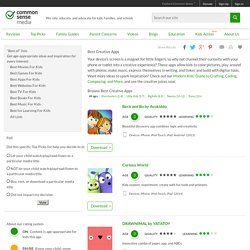
Get the App Get the App No thanks. Drawing Pad (Age 4+) Faces iMake - Right Brain Creativity (Age 5+) Toontastic (Age 6+) Wreck This App (Age 8+) ArtStudio - Draw, Paint and Edit Photo (Age 15+) GarageBand (Teens & Adults) Vine (Adult) Flowpaper (Adult)